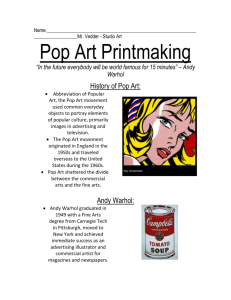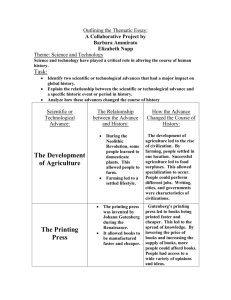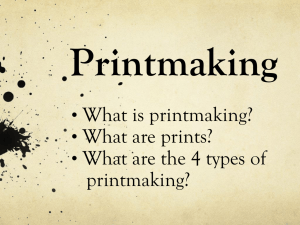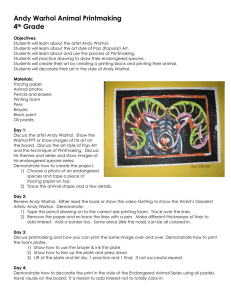Lithographic Printing - Kenston Local Schools
advertisement
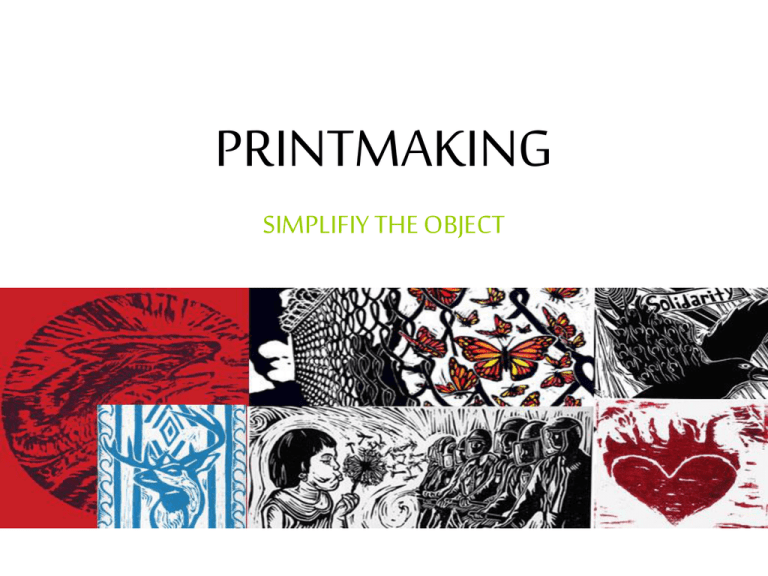
PRINTMAKING SIMPLIFIY THE OBJECT WE WILL DISCUSS: THE HISTORY OF PRINTMAKING PROJECT: LINOCUT ARTISTS: BANKSY KIETH HARING ANDY WARHOL PERIOD OF ART: POP ART A BRIEF HISTORY OF PRINTMAKING • The earliest known origin of printing is traceable to Chinese scribes in the first century, who developed moveable type. • The Chinese are also credited with the invention of paper – The Chinese could reproduce dozens or even hundreds of duplicate documents. – The information was only available to the wealthy or elite classes. – Even though the idea was revolutionary it did not spread throughout the world. Multimedia INFT 140 3 • The early " revolution" of moveable printing failed to ignite the world. • The process of producing printed versions of Chinese texts was more time consuming than traditional hand-inscribing. • Storing the thousands of characters in the Chinese alphabet was a problem. • Pen and oil-based ink was more efficient. HISTORY OF PRINTMAKING JOHANNES GUTENBERG 1436 • Johannes Gutenberg 1436 was a profit-minded goldsmith from Southern Germany. • His motivation was personal profit: he hoped to get rich by mass-producing the Church's ever-popular "indulgences". JOHANNES GUTENBERG • The Guttenberg Bible – (The number of lines of text on each page.) was printed two pages at a time for 1300 pages. • Gutenberg adapted a wine press of the day to use in assembling pages. THE PRINTING PRESS • The amount of information in one Sunday New York Times is greater than the amount of information an 18th century person in England would be exposed to in his lifetime. PRINTMAKING AND ART • A few decades after woodcut, metal engraving started. It was an art that only the goldsmiths and weapon makers used. The earliest printed engraving is from 1446 which is a German print. Germany gets the credit for developing intaglio printing from where it made its way to Italy and the Low Countries. PRINTMAKING AND ART •In the 17th century, printing was seen as ornamental decorations all over Europe. This form of printmaking was primarily used for decorating portraits and paintings. Intaglio printing at this time was done with the help of acid as artists at that time considered it to be a work of creativity. THE PASSAGE OF TIME • As the New World ( America ) grew in importance so did the media of printed communication. • Gutenberg's technology did not change for 400 years. • The next revolution was the invention of continuous rolls of paper. • Print availability to the public jumped astronomically. THE PRINTING PROJECT YOU ARE GOING TO SIMPLIFI Y AN OBJECT AND CARVE IT OUT OF A PIECE OF LINOLEUM. THE INK THE LINOLEUM PLATE AND PRINT IT ONTO A PIECE OD PAPER. WHY DO YOU THINK ARTIST CREATE A PRINT RATHER THEN ANOTHER MEDIUM…LIKE DRAWING OR PAINTING? WOOD BLOCKS ARE USED OTEN IN PRINTMAKING, BUT PERCISION IS DIFFICULT LINOCUT . LINOLUEM IS AN ESSIER SURFACE TO WORK WITH AND ALLOWS A MORE ACCURATE CUT… LINO CUT EXAMPLES PRINTING PROJECT: SIMPLIFY AN OBJECT…ARTISTS THAT SIMPLIFY OBJECT KIETH HARING...BANKSY...WARHOL WHO ARE THESE ARTIST AND WHAT TYPE OF WORK DID THEY CREATE? BANKSY KEITH HARING ANDY WARHOL POP ART is an ART MOVEMENT that emerged in the mid 1950s in BRITAIN and in the late 1950s in the UNITED STATES. Pop art challenged tradition by asserting that an artist's use of the mass-produced visual commodities of popular culture is contiguous with the perspective of FINE ART. Pop removes the material from its context and isolates the object, or combines it with other objects, for contemplation. The concept of pop art refers not as much to the art itself as to the attitudes that led to it POP ART & PATTERN…YOUR PRINTING PROJECT MUST COMBINED A SIMPLIFIED IMAGE AND PATTERN TIME TO GET TO WORK…GET OUT YOUR OBJECT AND SKETCHBOOK CREATE 4 QUICK SKETCHES…OF WHAT YOU THINK YOU WHAT YOUR PRINT TO LOOK LIKE… WHEN I APPROVE IT, I WILL GIVE YOU A PIECE OF TRACING PAPER TO START YOU FINAL DESIGN

